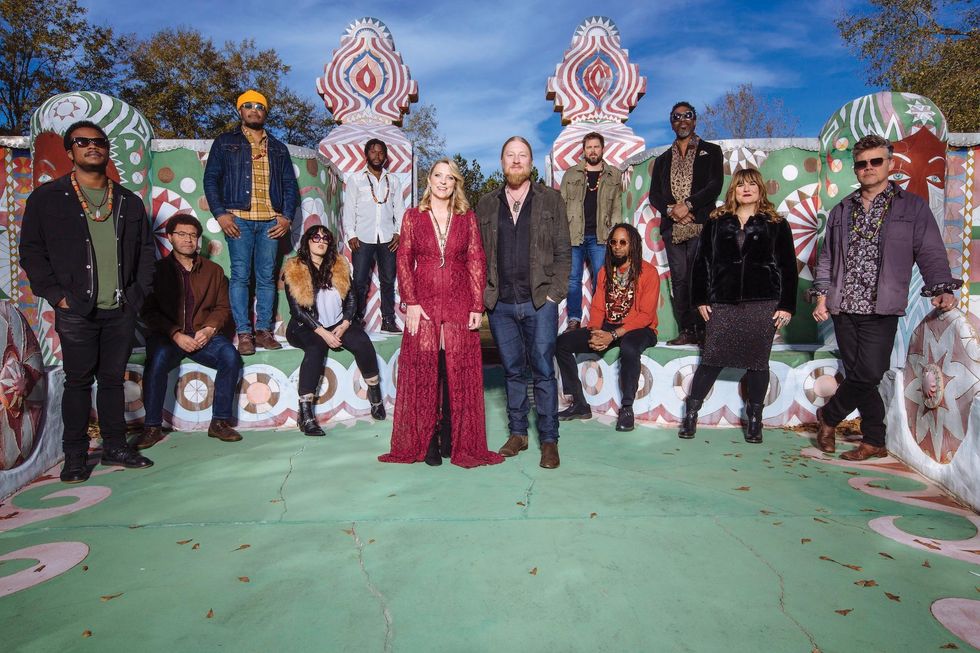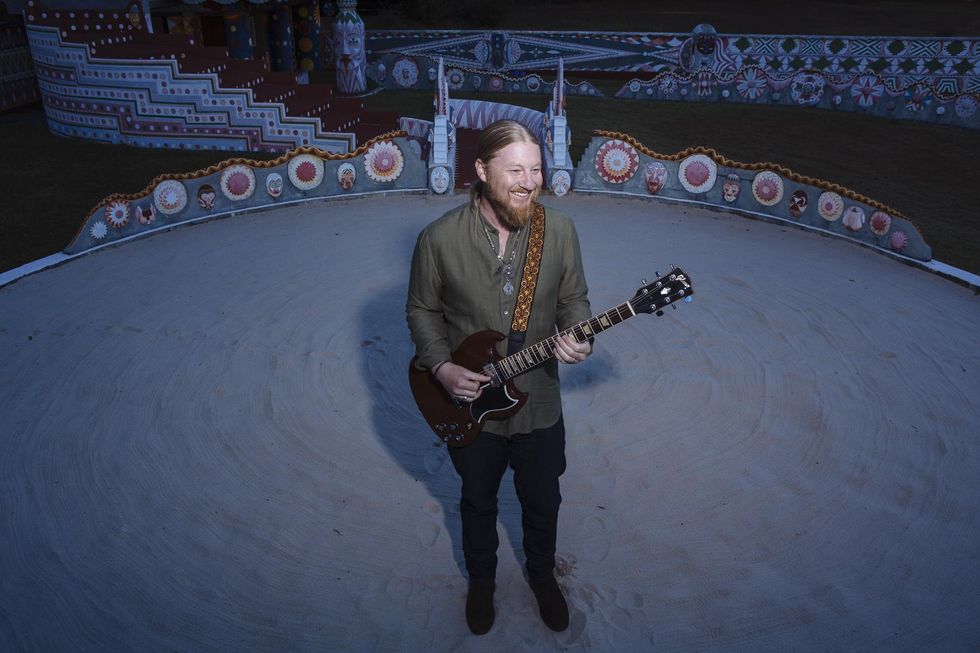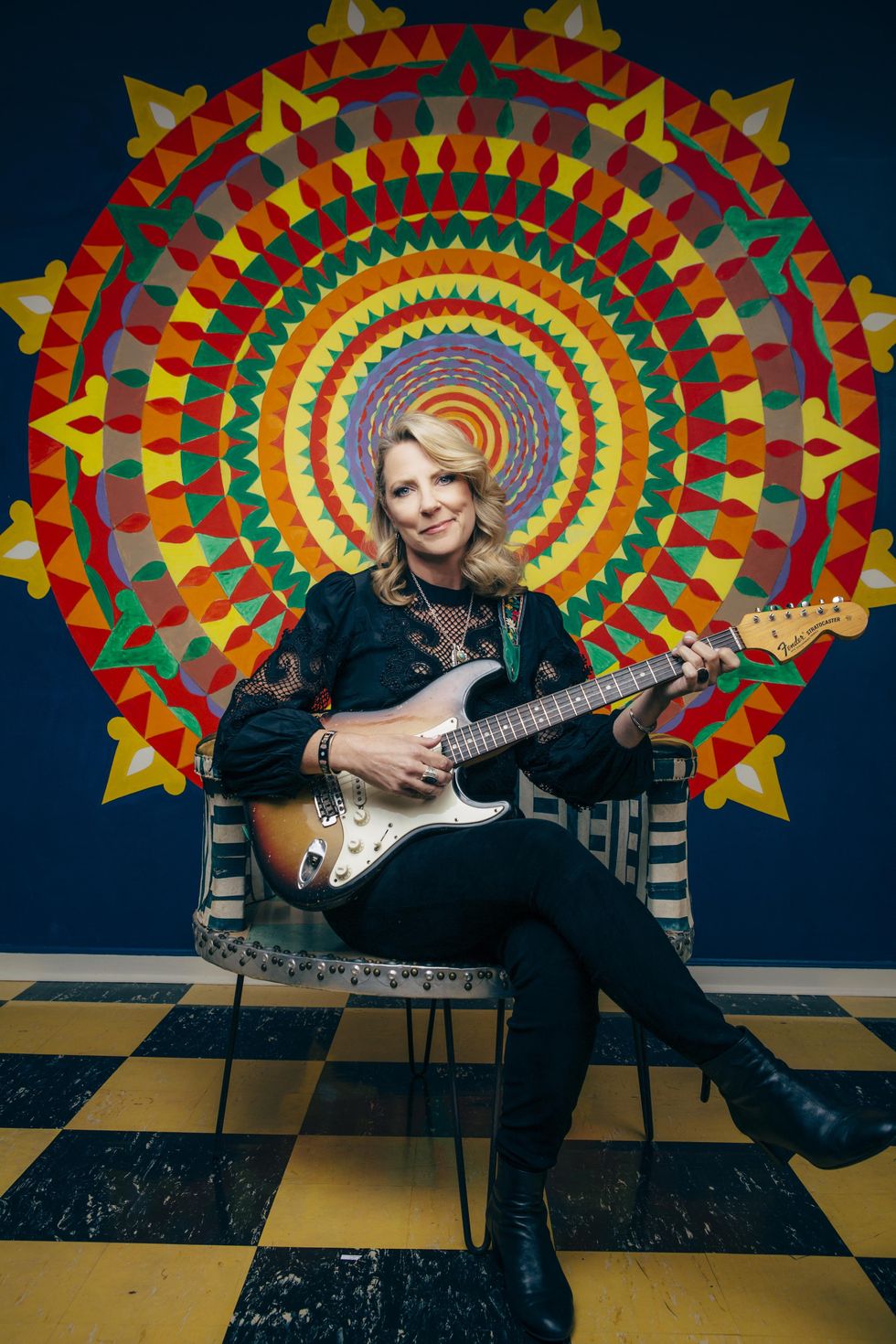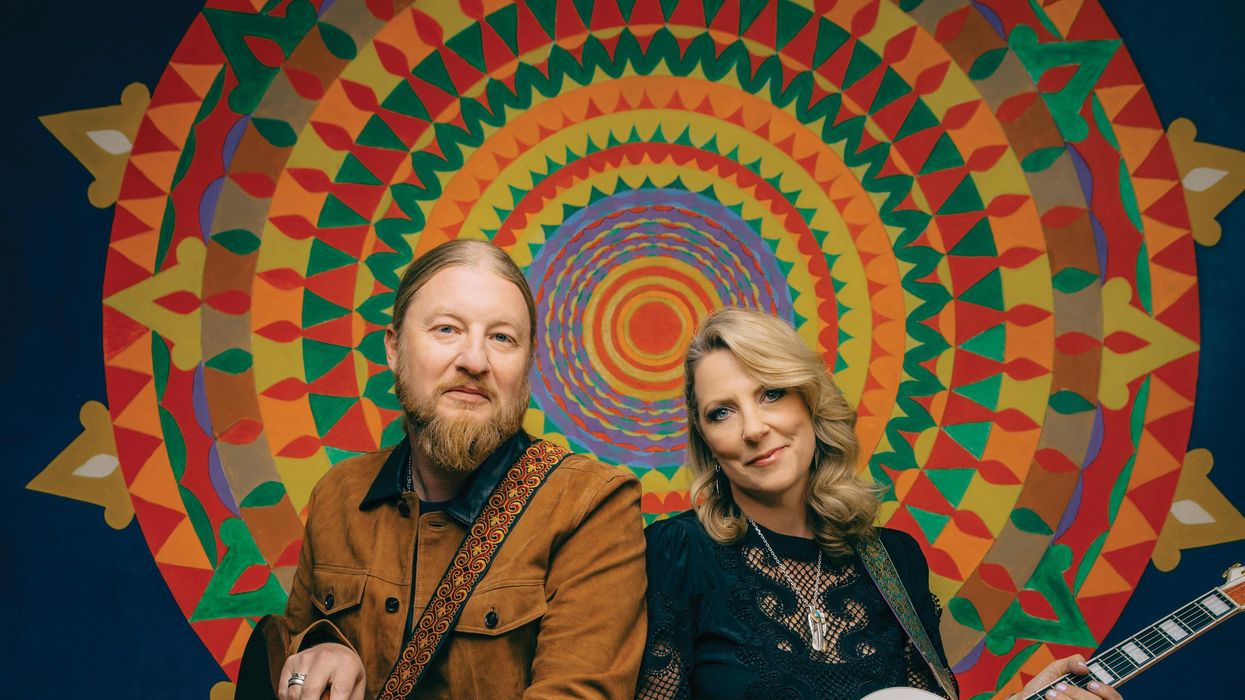Sometimes the universe brings together timeless energies that seem destined to explode into a beautiful new creation. All they need is the right people to harness them and unlock their potential. In the case examined here, those energies included an ancient Persian love story, a legendary ’70s rock album, the sometimes-painful realities of relationships, and a worldwide pandemic. The people are the wife-and-husband guitar duo of Susan Tedeschi and Derek Trucks, along with the 10 other members of their Tedeschi Trucks Band (TTB). The creation? A four-part multimedia masterwork titled I Am the Moon.
As their fans know, Tedeschi, who’d built her career on stinging Tele tones and one of the most soulful blues voices in modern music, and Trucks, an electric slide prodigy who first made waves as a solo artist before joining the Allman Brothers Band, met in 1999, fell in love, married, and started a family. In 2010, their careers united as well when they formed TTB with a rotating cast of equally exceptional musicians. Many tours, four studio albums, a Grammy, and eight Blues Music Awards later, TTB has become something more akin to a rambling roots-music collective than a band.
Tragedy struck the ensemble in February 2019, with the death of original band member and multi-instrumentalist Kofi Burbridge (brother of former TTB bassist Oteil Burbridge). The group was devastated. Then, while still dealing with the loss of their dear friend, Covid put a hard stop to the entire music industry. Something had to give.
Tedeschi Trucks Band - I Am The Moon: Episode I. Crescent
“After the loss of Kofi and Covid, we felt like we needed to hard reset to figure out where we were,” Trucks observes. Away from the road, Tedeschi and Trucks poured their energy into the relationships that matter most—their own family.
“When the lockdown happened, our son was moving on to college,” Tedeschi says. “There was a real sense of, ‘This is our last real hang time with him.’ It was really nice to be in a place with our kids where none of us could go anywhere, and we actually got to spend real quality time together.”
According to Tedeschi, sending their son off into the world inspired one of I Am The Moon’s songs, “La Di Da.” But Covid and a difficult goodbye were only two of the energies coalescing into what would be TTB’s most ambitious project.
Meanwhile, Mike Mattison, TTB vocalist and guitarist, was immersing himself in the seventh-century poem Layla and Majnun, credited to Persian poet Nizami Ganjavi, and the 1970 album it inspired, Derek and the Dominos’ Layla and Other Assorted Love Songs. The band had already been examining the musical side of these works and had recorded a live rendition of the Layla album, with guest Trey Anastasio, at the 2019 Lockn’ Festival. That performance was released as Layla Revisited Live at Lockn’ in May 2021. The poem is considered the East’s Romeo and Juliet. It follows two lovers through a timeless tale of passion, joy, separation, and death. Eric Clapton and Duane Allman’s collaboration focused heavily on Manjun’s side of the story. And Mattison wanted to give it a twist.

Initially, TTB’s members began to work on the I Am the Moon album cycle apart during lockdown, but they amassed at Derek and Susan’s home when it was time to record.
Photo by David McClister
“He had been kicking around this idea of taking the Layla concept and flipping it on its head—thinking about the story from Layla’s perspective,” Trucks says. “He reached out to everyone in the band with a suggestion that we all dig into the poem while we’re at home, before we could really get together. The concept was to keep everyone tight.”
With the members immersing themselves in Layla and Majnun, the creative juices quickly began flowing. But to capture the results, Tedeschi and Trucks would need to bring the entire band together. So, after a whirlwind of quarantining, vaccines, and negative test results, TTB’s players moved in with Susan and Derek. “They came down and lived with us, the core of the band,” say Trucks. “Once a few of the songs were written, that creativity started really inspiring everybody and sparking ideas. It had its own gravity at that point. I’ve never been a part of anything quite like it.”
“It was nice having no rules and no time constraints and being able to let things flow and happen organically.”—Susan Tedeschi
Many songs and arrangements were created in the moment, right on the studio floor. According to Trucks, that gave the recordings the energy of being onstage. “We track with the core of the band. It’s two drums, bass, me and Sue, and keyboards. Sue’s usually in a vocal booth, either with a guitar and a quiet amp in the room or an amp in another room. I’m set up in the same room as the drummers with a big tent around my amp. So, it felt a lot more like it feels onstage when we’re exploring.”
While many songs were brought in by individual band members, Tedeschi agrees that the relaxed, open environment was crucial to the songwriting process. “It was really cool to hear some of the things that the other musicians were coming up with,” she says. “The boys would play the riff or something, like on ‘All the Love,’ and it was really fun to sing against. I was trying to take in everything that was going on in the moment, as well as the poem. So, as Derek was saying earlier, it was nice having no rules and no time constraints and being able to let things flow and happen organically.”
Derek Trucks’ Gear

Trucks’ primary instrument for I Am the Moon was the fourth prototype for the Gibson Custom Shop’s Dickey Betts SG VOS.
Photo by David McClister
Guitars
- Gibson Custom Shop Dickey Betts SG VOS prototype No. 4
- 1965 Gibson ES-335
- 1960s Supro tuxedo finish
- Vintage National resonator
- Vintage Gibson Roy Smeck acoustic
- 1930s Gibson L-00 with DeArmond pickup
- Various vintage Martin acoustics
Amps
- Early ’60s Fender Deluxe
- 1950s tweed Fender Deluxe
Effects
- Leslie cabinet
- Vintage Echoplex
Strings & Slide
- DR Customs
- Coricidin bottle slide
That freedom also applies to Trucks’ solos. “They’re all improv, mostly,” he says. “The solos are live on the floor because they’re what’s leading the track at that moment. Some of the solos you definitely think about more than others, but a lot of them, they happen naturally. That seems to be the best way.”
Though Trucks’ thick tone and inimitable slide work are all over nearly every song, Tedeschi’s rhythm playing drives the whole project. And when the two cut heads, as on “Playing With My Emotions,” it’s pure blues-rock magic. “‘Playing With My Emotions’ was actually in the moment,” Tedeschi remembers. “Derek looks over at me and is like, ‘Play!’ I’m like, ‘Oh, okay.’” [laughs]
“I haven’t used any Echoplexes or Leslies and things like that on our stuff. One of these days, I’ll get into it.”—Susan Tedeschi
“It’s fun when, thematically, that makes sense,” Trucks says. “But it wasn’t written or scripted when we went to that. Me and Sue, we play the dueling-guitar stuff live. An old friend, Colonel Bruce Hampton, would call them guitarguments.” [laughs]
“Playing With My Emotions” perfectly illustrates both players’ approach to tone. Trucks is all about his signature, driven slide sound, which is perfectly offset by Tedeschi’s cleaner-yet-still-biting Tele.
Susan Tedeschi’s Gear

Tedeschi played her 1970 Fender Stratocaster for the sessions. TTB fans regularly see this guitar, as well as her longtime favorite, a ’90s Telecaster, in concert.
Photo by David McClister
Guitars
- 1990s Fender Telecaster
- Late 2000s Gretsch White Falcon
- 1970 Fender Stratocaster
Strings & Picks
- DR .010s
- Fender Heavy
Amps
- 1964 Fender Deluxe Reverb
Effects
- 1968 Vox Clyde McCoy wah (gift from Jorma Kaukonen)
“I was using my Tele through my ’64 Deluxe [Reverb],” she says. “Whatever came out in that moment is what you got. I had every intention to go back in later and re-do it, but it never happened.”
If you’ve seen Tedeschi onstage, you’ve probably seen that Telecaster. It’s also featured on the cover of her breakout solo album, Just Won’t Burn. But, as Trucks remembers, the Tele wasn’t her only go-to for these sessions. She also played her 1970 Fender Strat, and a Gretsch White Falcon on “Circles ’Round the Sun.”
Trucks employed a wider range of instruments to cover the music’s acoustic, resonator, and electric tones. “I think on ‘Fall In,’ I’m using a National that we ended up running through an old Supro amp,” Trucks says. “And I have this old Supro [a 1960s tuxedo model] guitar that I use as well. We used a lot of different acoustic guitars. I have a 1930s Gibson L-00 that has an old DeArmond pickup, like Elmore James, that I used a few times. I think on ‘Emmaline’ I was playing that. I have an old Gibson Roy Smeck. And there are a few old Martins that we use.” In the studio, Derek goes for early-1960s Fender Deluxes.
“Me and Sue, we play the dueling guitar stuff live. An old friend, Colonel Bruce Hampton, would call them guitarguments.”—Derek Trucks
Although they use similar amps, Tedeschi and Trucks take wildly different approaches to their sounds. “I haven’t really done a ton of experimenting yet,” said Tedeschi. “I haven't used any Echoplexes or Leslies and things like that on our stuff. Those are all really fun, but for the most part, on this record, I’m playing vibrato or a wah. One of these days, I’ll get into it. I don’t know why I haven’t. I do enjoy doing that.”
While sticking to tones with plenty of vintage vibe, Trucks explores a bit more. His only rule is it has to sound great in the track. “A lot of times, me and Bobby T [longtime TTB recording engineer and road manager Bobby Tis] would experiment,” he says. “I would always have a second amplifier upstairs being recorded for some extra room sound. A lot of times, we would put a vintage Echoplex on it for a little bit of smudge. I would use that old Supro sometimes with that setup. I would plug into the Leslie quite a bit, too, for certain overdubs or a song like ‘Circles ’Round the Sun.’ It think that song is my guitar going through my Deluxe and an actual Leslie, which is a pretty great sound. Then there’s one or two songs where I took the solo on a tweed Deluxe. But it’s funny. You can get a sound on the floor that sounds incredible, and then you take a solo and you realize it’s either too little of something or too much of something.”
Rig Rundown - Tedeschi Trucks Band
Tedeschi has used her Tele for gathering autographs over the years. Easily readable are signatures from B.B. King. Hubert Sumlin, John Lee Hooker, and Clarence “Gatemouth” Brown. Check out the live gear used by Derek and Susan.
Trucks’ standout moment comes early in the four-album collection as he guides the band through the only instrumental, I Am the Moon: I. Crescent’s closing track, “Pasaquan.” Clocking in at over 12 minutes, the song is part Allman-style jam, part Middle Eastern melodicism, and part Floydian expanse. With a song like that, Trucks knew the band had to nail it. It had to sound electrifying.
“I didn’t want to play it more than once or twice in a row, ever,” says Trucks. “I wanted to make sure that, when we did capture it, it would be spontaneous. We really took wildly different approaches each time we played it.” Trucks also took an uncharacteristic approach to both his gear and technique on “Pasaquan.”
“I used a 1965 335 on it and tuned down to D. I realized there was no other way to get that sound. It’s made for that tune. And it’s all fingers. Over years of being onstage with the Allman Brothers, you’d have to improvise quite a bit in different ways, so you get your chops up for that.”
About the chapters of I Am the Moon—I. Crescent, II. Ascension, III. The Fall, IV. Farewell—Trucks says, “We had this episodic concept pretty early on, and we had the album titles pretty early on. We were listening to a lot of vinyl, and I started realizing that all of our favorite records were cut for vinyl, which is 35 or 40 minutes. We knew we had the right amount of material for that, and it worked.”
“We track with the core of the band. It’s two drums, bass, me and Sue, and keyboards.”—Derek Trucks
All four episodes were released a month apart to let listeners absorb each album of the saga to its fullest. But together, a beautiful story of love, distance, creation, and saying goodbye unfolds. This approach to releasing the albums paid off, and fans embraced the music faster than any previous TTB title.
“When we did the first show of this summer tour, I think we played two of our old original tunes, and then we did the whole Crescent record, start to finish,” Trucks says. “We were a little bit shocked at how well it went. Usually, when you break out new material, there’s a little bit of air that goes out of the room. This time around, it seemed like people connected with it pretty early on. Even when we’d get done playing the new stuff and go back to some of our older stuff, it didn’t have the same weight.”
“The poem was interesting, because you have a lot of different correlations with family and how everybody’s affected by each other,” she says. “Here, Layla is in a situation where she’s in love, and she has to be able to let go of it. She has to be able to say goodbye even though she doesn’t want to. I thought it had a parallel to being able to let go and say goodbye to my son. It was the perfect story and the perfect concept for that time.”
YouTube It
Watch Susan and Derek and their comrades in song play the title track from their multi-media extravaganza, I Am the Moon. Oh, and be sure to hang for Derek’s epic slide solo at 4:25!






![Rig Rundown: Russian Circles’ Mike Sullivan [2025]](https://www.premierguitar.com/media-library/youtube.jpg?id=62303631&width=1245&height=700&quality=70&coordinates=0%2C0%2C0%2C0)
































![Rig Rundown: AFI [2025]](https://www.premierguitar.com/media-library/youtube.jpg?id=62064741&width=1245&height=700&quality=70&coordinates=0%2C0%2C0%2C0)











